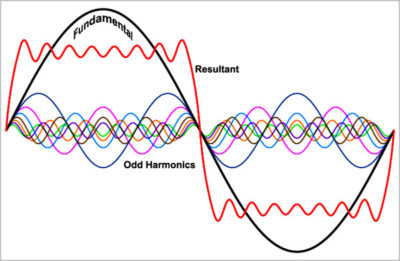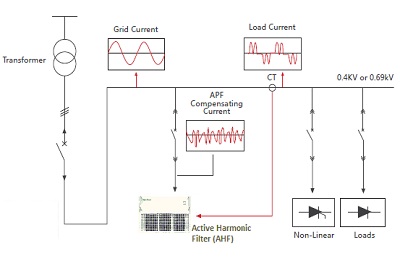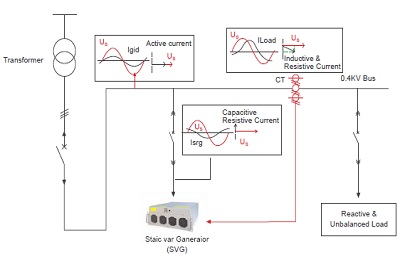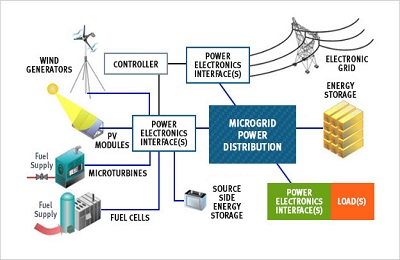- Utility based solutions for the substation level
- User based solution for whole facility protection
- User load level solutions for specific loads
- Designed in solutions, built in by the equipment manufacturer to reduce the sensitivity to Power Quality problems
- A piece of equipment mis-operates at the same time of day
- Circuit breakers trip without being overloaded
- Equipment fails during a thunderstorm
- Automated systems stop for no apparent reason
- Electronic systems fail or fail to operate on a frequent basis
- Electronic systems work in one location but not in another location
- Lights dim or blink and electronic systems mis-operate
1. What is Power Quality?

Many answers apply to this simple question. They all depend on your perspective.
From the utility perspective, Power Quality has been defined as the parameters of the voltage that affect the customers super-sensitive equipment.
From the power user perspective, Power Quality may be defined as any electrical parameter or connection that affects the operation of the equipment. This includes all electrical parameters, connections and grounds, whether the source from the utility, local equipment or other users.
From the Power Quality market or industry perspective, it is any product or service that is supplied to users or utilities to measure, treat, remedy, educate engineers or prevent Power Quality issues, problems and related items.
2. What is the most common Power Quality problem?
Voltage sags are considered the most common Power Quality problem. These can be caused by the utility or by customer loads. When sourced from the utility, they are most caused by faults on the distribution system. These sags will be from 3 to 30 cycles and can be single or three phases. Depending on the design of the distribution system, a ground fault on 1 phase can cause a simultaneous swell on another phase.
3. What is the second most common Power Quality problem?
A recent survey of Power Quality experts indicates that 50% of all Power Quality problems are related to grounding, ground bonds, neutral to ground voltages, ground loops, ground current or other ground associated issues.
4. What type of equipment is affected by power Quality issues?
An electrically operated or connected equipment is affected by Power Quality.
5. Why has Power Quality only become an issue in recent years?
Power Quality has been an issue since electrical power was invented. It has only become a well published issue in recent years because of the loads it affects. If your favorite TV program is interrupted by the local sewage pump operating on a Variable Speed drive interfering with it, you are aware of a Power Quality problem. When the lights blink and your PC reboots, you are aware of a Power Quality problem. The electrical loads get more sensitive.
6. What are the types of Power Quality solutions available on the market today?
There are few reputed manufacturers making different types of Power Quality solutions today. Nexus Power Solutions is one out of it.
The categories of these solutions are:
Contact Nexus Power Solutions for detailed solutions for specific problems. You can send your queries through Contact Us page.
7. How can Power Quality problems be detected?

Determining the exact problems requires sophisticated electronic test equipment. The following symptoms are indicators of Power Quality problems:
8. What are Harmonics?
Harmonics are distortions in the AC waveform. These distortions are caused by loads on the electrical system that use the electrical power at a different frequency than the fundamental 50 or 60 Hz. An example of such a load is the common PC, television receiver or any other electronic load
9. What causes harmonic currents?
Nonlinear loads are the source of harmonic currents. That is, the load’s current waveform is non-sinusoidal. As a result, the distorted current waveform is rich in sinusoidal harmonic current wave forms.
Nonlinear loads include electronic devices such as rectifiers, current controllers, AC and DC drives, cyclo-converters and devices with switch-mode power supplies such as computers, monitors, telephone systems, printers, scanners, and electronic lighting ballasts.
10. What causes harmonic voltages?
The electrical distribution system’s harmonic impedance cause the load-generated harmonic currents to produce harmonic voltages (EH = IH x ZH). Transformers, and feeder and branch circuit impedance will cause maximum voltage distortion at the nonlinear loads.
11. How do harmonics affect the electrical system?
In general harmonics cause magnetic portions of the electrical system to overheat. Such as transformers, line reactors, magnetic relays and power factor capacitors.
12. How do harmonics affect the load?
The effect of harmonics on loads varies a great deal and is dependent on the load itself. Most loads are not affected by moderate levels of harmonics. Exceptions to this are loads that perform electrical measurements in the frequency domain of the harmonics.
13. How do I measure/characterize Power Quality?
It requires specialist, measurement equipment to measure, record and diagnosis harmonic problems. Because most equipment does not specify what level of power quality is required. Nexus Power Solutions offers a service of characterizing all aspects of Power Quality and determining if it is acceptable to the load.
14. Have any other questions?
Get in touch! Send your queries through Contact Us page.
1. Why providing an Active Harmonic Filter (AHF) in Electrical Network?
Active Harmonic filters use IGBT fired circuits to mitigate harmonic distortions in the load or the network of loads where they are installed. The advanced AHF system is constructed of one or several filter modules with system controller. AHF eliminate harmonic injected into the mains supply by non-linear loads. Its response time is extremely fast and is connected in parallel to the load which is to be compensated. Current harmonic elimination is achieved by sensing load current & extracting harmonic current signal. This and the reactive current signal together are used to generate a reference for the controlled current source connected at the PCC (point of common connection) of source and load. These results in Mains supplying only real power for the load and reactive & harmonics being sourced from the AHF. This is carried out dynamically, so that any change in the load pattern or its nature is immediately responded without any manual intervention
2. How Active Harmonic filter works?

Active Harmonic filters are connected in parallel with the loads to be compensated. They measure the current of the non-linear load and inject the same harmonics, but with opposite phase angle. The current of the active harmonic filter thus cancels out the harmonic currents of the load, and only fundamental frequency current component is left to be supplied from the power system. In addition to current and voltage profile smoothing by harmonic current mitigation, the active filters also provide fast fundamental frequency reactive power compensation and balance loads in three-phase systems. Reactive power compensation stabilizes voltage, mitigates flicker, releases additional capacity for transferring more active power in the existing electrical network and improves the power factor. Fast response to reactive power changes is important, for example, in electric arc furnaces. A typical case where load balancing is needed is a phase-to-phase connected welding equipment that burdens only two of the three lines and can thus create voltage unbalance between the phases.
3. How Active Filters are better than Passive Filters?
As the name suggests, passive filters are made up of passive devices (capacitors and inductors) and it does not have capability to sense the real time condition. Whereas the Active Harmonics Filters are active device. It monitors the harmonics in the system continuously and cancels the harmonics effectively without any negative impact on the system.
4. Have any other questions ?
Get in touch!
1. What is SVG?

Static Var Generator or Compensator (SVG or SVC) is a device that can quickly and reliably control line voltages. An SVG will typically regulate and control the voltage to the required set point under normal steady state and contingency conditions and thereby provide dynamic, fast response reactive power following system contingencies (e.g. network short circuits, line and generator disconnections).
The principle of the SVG is very similar to that of Active Power Filter. When the load is generating inductive or capacitive current, it makes load current lagging or leading the voltage. SVG detects the phase angle difference and generates leading or lagging current into the grid, making the phase angle of current almost the same as that of voltage on the transformer side, which means fundamental power factor is unit.
1. What is SVGC?
Hybrid Static Var Generator (SVGC) systems provide instantaneous and infinitely variable power factor correction for industrial networks containing highly transient or unstable loads, as well as system compensation for large AC motor inrush current.
The SVGC system integrates conventional power factor correction systems and the latest IGBT-based solutions to provide ultra-rapid response and infinitely variable kVAR control never before seen in a power factor correction product. Specifically designed for the instantaneous support required by welding equipment, the SVGC eliminates voltage sags and voltage flicker while increasing system capacity, providing energy savings and improving weld quality.
2. Have any other questions ?
Get in touch!
1. What is Energy Storage Systems?

The Energy Storage Systems (ESS) built on state-of-the-art-technology are modular solutions in terms of output power and energy. Variety of operation modes and flexibility to connect to any voltage level, makes Nexus Power ESS a preferred solution for complete electricity system value chain starting from the generation. Particularly renewable energy integration, and from Transmission and Distribution (T&D) down to hybrid, island and microgrids. Built-in flexible design permits easy scalability to deliver customized solution from few hundreds of kWh to several hundred MWh. Typical operation modes of Nexus Power ESS include but not limited to are: frequency & voltage regulation, peak shaving and intermittent power support including unique power quality modes.